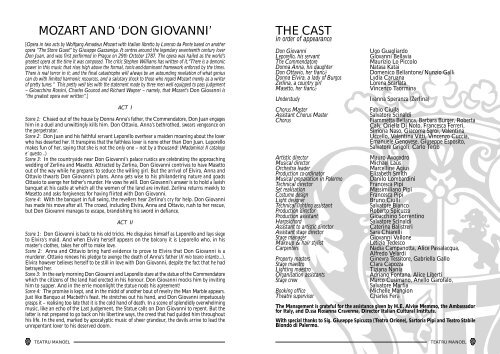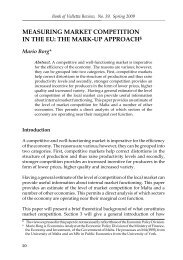DON GIOVANNI - Bank of Valletta
DON GIOVANNI - Bank of Valletta
DON GIOVANNI - Bank of Valletta
Create successful ePaper yourself
Turn your PDF publications into a flip-book with our unique Google optimized e-Paper software.
1732<br />
MOZART AND ‘<strong>DON</strong> <strong>GIOVANNI</strong>’<br />
[Opera in two acts by Wolfgang Amadeus Mozart with Italian libretto by Lorenzo da Ponte based on another<br />
opera “The Stone Guest” by Giuseppe Gazzaniga. It centres around the legendary seventeenth century lover<br />
Don Juan, and was first performed in Prague on 29th October 1787. The opera was hailed as the world’s<br />
greatest opera at the time it was composed. The critic Stephen Williams has written <strong>of</strong> it,“There is a demonic<br />
power in this music that rises high above the formal, tonic-and-dominant framework enforced by the times.<br />
There is real terror in it; and the final catastrophe will always be an astounding revelation <strong>of</strong> what genius<br />
can do with limited harmonic resources, and a salutary shock to those who regard Mozart merely as a writer<br />
<strong>of</strong> pretty tunes.” This pretty well ties with the statement made by three men well equipped to pass judgement<br />
– Gioacchino Rossini, Charles Gounod and Richard Wagner – namely, that Mozart’s Don Giovanni is<br />
“the greatest opera ever written”.]<br />
TEATRU MANOEL<br />
ACT I<br />
Scene 1: Chased out <strong>of</strong> the house by Donna Anna’s father, the Commendatore, Don Juan engages<br />
him in a duel and unwittingly kills him. Don Ottavio, Anna’s bethrothed, swears vengeance on<br />
the perpetrator.<br />
Scene 2: Don Juan and his faithful servant Leporello overhear a maiden moaning about the lover<br />
who has deserted her. It transpires that the faithless lover is none other than Don Juan. Leporello<br />
makes fun <strong>of</strong> her, saying that she is not the only one – not by a thousand! (Madamina! Il catalogo<br />
e’ questo…)<br />
Scene 3: In the countryside near Don Giovanni’s palace rustics are celebrating the approaching<br />
wedding <strong>of</strong> Zerlina and Masetto. Attracted by Zerlina, Don Giovanni contrives to have Masetto<br />
out <strong>of</strong> the way while he prepares to seduce the willing girl. But the arrival <strong>of</strong> Elvira, Anna and<br />
Ottavio thwarts Don Giovanni’s plans. Anna gets wise to his philandering nature and goads<br />
Ottavio to avenge her father’s murder. He vows he will. Don Giovanni’s answer is to hold a lavish<br />
banquet at his castle at which all the women <strong>of</strong> the land are invited. Zerlina returns meekly to<br />
Masetto and asks forgiveness for having flirted with Don Giovanni.<br />
Scene 4: With the banquet in full swing, the revellers hear Zerlina’s cry for help. Don Giovanni<br />
has made his move after all. The crowd, including Elvira, Anna and Ottavio, rush to her rescue,<br />
but Don Giovanni manages to escape, brandishing his sword in defiance.<br />
ACT II<br />
Scene 1: Don Giovanni is back to his old tricks. He disguises himself as Leporello and lays siege<br />
to Elvira’s maid. And when Elvira herself appears on the balcony it is Leporello who, in his<br />
master’s clothes, takes her <strong>of</strong>f to make love.<br />
Scene 2: Anna and Ottavio bring hard evidence to prove to Elvira that Don Giovanni is a<br />
murderer. Ottavio renews his pledge to avenge the death <strong>of</strong> Anna’s father (Il mio tesoro intanto…).<br />
Elvira however believes herself to be still in love with Don Giovanni, despite the fact that he had<br />
betrayed her.<br />
Scene 3: In the early morning Don Giovanni and Leporello stare at the statue <strong>of</strong> the Commendatore<br />
which the citizens <strong>of</strong> the land had erected in his honour. Don Giovanni mocks him by inviting<br />
him to supper. And in the errie moonlight the statue nods his agreement!<br />
Scene 4: The promise is kept, and in the midst <strong>of</strong> another bout <strong>of</strong> revelry the Man Marble appears.<br />
Just like Banquo at Macbeth’s feast. He stretches out his hand, and Don Giovanni impetuously<br />
grasps it – realising too late that it is the cold hand <strong>of</strong> death. In a scene <strong>of</strong> splendidly overwhelming<br />
music, like an echo <strong>of</strong> the Last Judgement, the Statue calls on Don Giovanni to repent. But the<br />
latter is not prepared to go back on his libertine ways, the creed that had guided him throughout<br />
his life. In the end, marked by apocalyptic music <strong>of</strong> sheer grandeur, the devils arrive to lead the<br />
unrepentant lover to his deserved doom.<br />
THE CAST<br />
in order <strong>of</strong> appearance<br />
Don Giovanni Ugo Guagliardo<br />
Leporello, his servant Giovanni Bellavia<br />
The Commendatore Maurizio Lo Piccolo<br />
Donna Anna, his daughter Natasa Katai<br />
Don Ottavio, her fiancè Domenico Bellantone/Nunzio Gallì<br />
Donna Elvira, a lady <strong>of</strong> Burgos Lydia Caruana<br />
Zerlina, a country girl Lorena Scarlata<br />
Masetto, her fiancè Vincenzo Taormina<br />
Understudy Ivanna Speranza (Zerlina)<br />
Chorus Master Fabio Ciulla<br />
Assistant Chorus Master Salvatore Scinaldi<br />
Chorus Fiammetta Bellanca, Barbara Burger, Roberta<br />
Caly, Oriella Di Noto, Francesca Ferreri,<br />
Simona Naso, Giacoma Sgroi, Valentina<br />
Uccello, Valentina Vitti, Vincenzo Cuccia,<br />
Emanuele Genovese, Giuseppe Esposito,<br />
Salvatore Grigoli, Carlo Terzo<br />
Artistic director Mauro Avogadro<br />
Musical director Michael Laus<br />
Orchestra leader Marcelline Agius<br />
Production co-ordinator Elizabeth Smith<br />
Musical preparation in Palermo Danilo Lombardini<br />
Technical director Francesca Pipi<br />
Set realisation Massimiliano Pipi<br />
Costume design Francesca Pipi<br />
Light designer Bruno Ciulli<br />
Technical lighting assistant Salvatore Bianco<br />
Production director Roberto Spicuzza<br />
Production assistant Gioacchino Sorrentino<br />
Harpsichord Salvatore Scinaldi<br />
Assistant to artistic director Caterina Balistreri<br />
Assistant stage director Sara Chiarelli<br />
Stage manager Giovanni Vallone<br />
Make-up & hair stylist Letizia Tedesco<br />
Carpenters Nadia Campanotta, Alice Passalacqua,<br />
Alfredo Velardi<br />
Property masters Ginevra Tessitore, Gabriella Gallo<br />
Stage maestro Clara Capozza<br />
Lighting maestro Tiziana Nania<br />
Organisation assistants Adriano Fontana, Alice Liberti<br />
Stage crew Marco Cusimano, Anello Gar<strong>of</strong>alo,<br />
Salvatore Marfia<br />
Booking <strong>of</strong>fice Michelle Mangion<br />
Theatre supervisor Charles Ferò<br />
The Management is grateful for the assistance given by H.E. Alvise Memmo, the Ambassador<br />
for Italy, and D.ssa Rosanna Cravenna, Director Italian Cultural Institute.<br />
With special thanks to Sig. Giuseppe Spicuzza (Teatro Orione), Sartoria Pipi and Teatro Stabile<br />
Biondo di Palermo.<br />
TEATRU MANOEL<br />
1732







